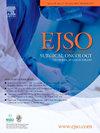基于 PET-CT 的宿主代谢(PETMet)特征与胃食管腺癌的病理反应相关。
IF 3.5
2区 医学
Q2 ONCOLOGY
引用次数: 0
摘要
背景:基于18F-FDG pet - ct的非肿瘤组织宿主代谢(PETMet)谱分析是一种将患者对癌症的特异性反应纳入临床算法的新方法。材料和方法:对前瞻性维护的胃食管癌患者机构数据库进行了预处理pet - ct、人口统计学和临床病理变量的查询。在9个非肿瘤组织(肝、脾、4个肌肉、3个脂肪部位)中测量18F-FDG PET贪婪度。采用Logistic回归和Cox回归分别对病理反应(PR)和总生存期(OS)进行建模。采用分类回归树(CART)和随机森林模型来创建决策树,并识别与结果相关的PETMet特征。结果:251例远端胃食管腺癌(48%)或胃腺癌(52%)被纳入研究。在调整临床变量后,pet - ct衍生的评分与PR独立相关。CART和Random Forest方法确定了非肿瘤组织18F-FDG贪婪度的关键分裂点,可以对患者进行分类并预测PR。由决策树创建的PET-CT风险组预测PR的效果明显优于临床模型(p 18F-FDG贪婪比(≥2.7)且脾脏18F-FDG贪婪度较低)。无监督决策树表明,内脏脂肪、皮下脂肪和肌肉中18F-FDG的低贪婪度导致最有利的PR,这表明全身性高代谢对预后有不利影响。本文章由计算机程序翻译,如有差异,请以英文原文为准。
PET-CT-based host metabolic (PETMet) features are associated with pathologic response in gastroesophageal adenocarcinoma
Background
18F-FDG PET-CT-based host metabolic (PETMet) profiling of non-tumor tissue is a novel approach to incorporate the patient-specific response to cancer into clinical algorithms.
Materials and methods
A prospectively maintained institutional database of gastroesophageal cancer patients was queried for pretreatment PET-CTs, demographics, and clinicopathologic variables. 18F-FDG PET avidity was measured in 9 non-tumor tissue types (liver, spleen, 4 muscles, 3 fat locations). Logistic and Cox regression were used to model pathologic response (PR) and overall survival (OS) respectively. Classification and regression tree (CART) and random forest modeling were employed to create decision trees and identify PETMet features associated with outcome.
Results
Two-hundred and one patients with distal gastroesophageal (48 %) or gastric (52 %) adenocarcinoma were included. PET-CT-derived scores were independently associated with PR after adjusting for clinical variables. CART and Random Forest methods identified critical split points of non-tumor tissue 18F-FDG avidity that can classify patients and predict PR. PET-CT risk groups created from decision trees predicted PR significantly better than the clinical model (p < 0.001). Specifically, an elevated erector spinae-to-gluteal fat 18F-FDG avidity ratio (≥2.7) combined with low 18F-FDG avidity in the spleen (<2.9) and rectus femoris (<0.52) predict PR. No advantage of PET-CT risk groups was seen for predicting OS (p = 0.155).
Conclusions
Pretreatment host PETMet features may be useful for predicting PR after neoadjuvant therapy in gastroesophageal cancer. Unsupervised decision trees indicate that low 18F-FDG avidity in visceral fat, subcutaneous fat, and muscle result in the most favorable PR, suggesting that systemic hypermetabolism adversely impacts prognosis.
求助全文
通过发布文献求助,成功后即可免费获取论文全文。
去求助
来源期刊

Ejso
医学-外科
CiteScore
6.40
自引率
2.60%
发文量
1148
审稿时长
41 days
期刊介绍:
JSO - European Journal of Surgical Oncology ("the Journal of Cancer Surgery") is the Official Journal of the European Society of Surgical Oncology and BASO ~ the Association for Cancer Surgery.
The EJSO aims to advance surgical oncology research and practice through the publication of original research articles, review articles, editorials, debates and correspondence.
 求助内容:
求助内容: 应助结果提醒方式:
应助结果提醒方式:


